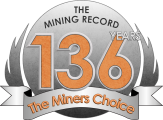Positive Metallurgical Test Results from the Laguna Salada Project
Positive Metallurgical Test Results from the Laguna Salada Project
TORONTO, ON – U3O8 Corp. CA:UWE +1.47% , a Canadian-based company focused on exploration and resource expansion of uranium and associated commodities in South America, reports positive alkaline leach results on the uranium- and vanadium-bearing gravels from the Guanaco area of the Laguna Salada Project, Chubut Province, Argentina. Highlights: 94% uranium extraction and 51% vanadium recovery from the upgraded fine component of the gravels; and Rapid uranium-vanadium extraction, with the best results achieved after only four hours of leaching.
"This excellent uranium recovery using alkaline leach – which is potentially lower cost than acid leach due to the modest reagent consumption expected – could further enhance the economic viability of the Laguna Salada as a potentially low-cost project," said Richard Spencer, U3O8 Corp’s President and CEO. "Laguna Salada has many positive characteristics. Firstly, uranium and vanadium lie within a few metres from surface in soft, unconsolidated gravel that should be amenable to low-cost mining techniques with no blasting or crushing required. Secondly, simple screening separation of the pebbles and coarse sand concentrates the uranium-vanadium in the fine material and increases uranium grades to approximately 620-670ppm – comparable to the head grades of similar deposits operating elsewhere in the world(1). Thirdly, most of the fine metal-rich material in the Guanaco area, which constitutes 90% of the Laguna Salada deposit, can be leached quickly with alkaline reagents achieving maximum uranium recoveries in only four hours. Metallurgical testing will be ongoing to optimize the recovery and beneficiation results that we have achieved to date."
The Laguna Salada Project contains two slightly different types of gravel located in distinct areas: the Guanaco and the Lago Seco sectors. Both gravels are soft and unconsolidated. Samples from various sites in each area were excavated with a backhoe and sent, without any processing or crushing, to SGS Lakefield’s laboratory in Lakefield, Ontario, where they were combined into one large sample from each area and underwent metallurgical testing.
Two alkaline leach tests were conducted on the Guanaco fines: one at a temperature of 80 degrees C over a 72-hour period and another at 90 degrees C over a 48-hour period. The best uranium recovery of 94.1% was achieved at a temperature of 90 degrees C after four hours of leaching. Uranium extraction decreased with time due to re-precipitation of uranium; hence, shorter leach times are advantageous. Vanadium extraction was 50.9% at four hours, rising to 59.1% after 48 hours.
Acid leach tests showed 74% uranium and 86% vanadium recovery after a leach time of 36 hours. Net acid consumption was 18.6 kilogram/tonne ("kg/t") per tonne of raw mineralized gravel.
Given the effectiveness of alkaline leach on the uranium at Guanaco and the expected modest consumption of reagents, alkaline leaching is probably an economically superior option at Guanaco, which contains 90% of the National Instrument 43-101 ("NI 43-101") uranium-vanadium resource at Laguna Salada.
Alkaline leach results were poor for material from Lago Seco due to the presence of gypsum, a mineral that reacts with, and consumes, the alkaline reagents. Tests conducted at temperatures of 80 degrees C and 90 degrees C showed recoveries of less than 5% for uranium and less than 10% for vanadium. In contrast, acid leach was very effective showing recoveries of 96% for uranium and 71% for vanadium after 36 hours of leaching with 49.5kg/t of acid consumption per tonne of raw mineralized gravel.
Additional metallurgical testwork will evaluate ways of optimizing the recovery of uranium and vanadium from the Guanaco and Lago Seco areas of the Laguna Salada deposit. A key attribute of Laguna Salada is the ease with which the fine-grained uranium and vanadium minerals can be concentrated into a small fraction of the raw gravel by simple screening to remove the coarse particles and pebbles. Tests conducted by SGS Lakefield showed that uranium and vanadium grades can be increased by four to 11 times in the screened fines. For uranium, this would lead to a head grade (the metal-rich fines that would enter a processing plant) of approximately 620-670ppm – similar to head grades of operating surficial uranium deposits elsewhere in the world. The Guanaco sector of Laguna Salada showed that a grade of 55ppm U3O8 was upgraded to a value of 623ppm U3O8 in the screened fines (11.4 times increase in uranium grade from the original raw gravel). A vanadium value of 349ppm V2O5 in the raw gravel increased to 1,893ppm V2O5 in the fine material (5.4 times increase in vanadium grade).




Comments (0)